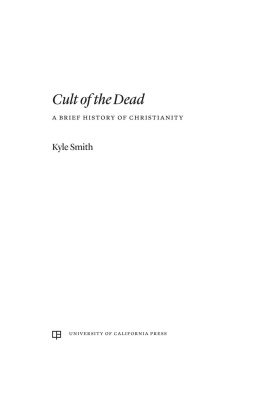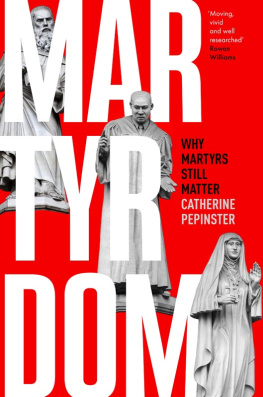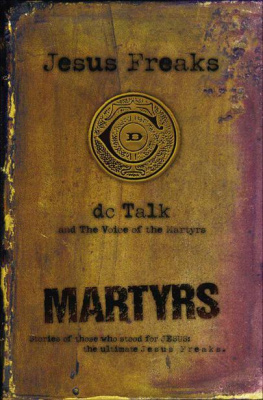EBSCOhost - printed on 7/30/2022 10:10 PM via . All use subject to https://www.ebsco.com/terms-of-use
PREFACE
Without realizing it, I planted the seeds for Divine Deliverance in the introduction to my first book, Dying to Be Men, when I hinted at the relationship between gendered language and the textual depiction of the martyrs as oblivious to the pain inflicted by torture. After that book was published, readers asked me regularly about this passing comment, which pressed me to think about the issue more carefully. How widespread are the assertions that mutilated and tortured bodies are neither harmed nor in pain? What is an audienceancient or modernto make of such incredible claims?
Intrigued, I returned to the texts with which I was most familiar: the second- and third-century Christian martyr narratives. This literature constructs the identities and reflects the desires and fundamental beliefs of nascent Christianities, and so it offers glimpses into early Christian interests and concerns. But rather than limiting my inquiry to these textswhich were the primary focus of Dying to Be Men I collected data from a wider variety of martyr texts. I examined both Jewish and Christian texts (of varying stripes) from across the Empire, written in both Greek and Latin, and that spanned over five centuries. I observed that while these texts describe torture, often in great detail, they dont describe the pain that would presumably result. In fact, the narratives reject the association of martyrdom with pain, employ several narrative tools to depict torture as not painful, and use the language of analgesiapainlessness. I began to explore reasons for these surprising claims beyond their implicit claims to masculinity; in particular, I was interested in the relationship between insensitivity to pain and certain trends in Stoic thought. When I shared my observations with colleagues, one of them asked a provocative question: Can the texts actually do what they seem to want to do?
Divine Deliverance is the result of my struggle with that question. In this book I work through the evidence that the texts try to depict martyrdom as painless, and I show how they (usually) manage to do so. I also wrestle with another colleagues astute question: Dont the texts undermine their own arguments when they so carefully catalogue the torture applied to Christian bodies? Can a text simultaneously detail dissolution and assert impassibilitythe inability to experience pain? And if pain is not a locus of meaning for the ideology of martyrdom in these texts, why do they describe torture so carefully?
In the process of developing this book, I have come to believe that when we approach martyr texts as primarily historical accounts of past events, we exacerbate the tension between cataloguing torture and rejecting pain. When we imagine the martyrs described in these texts as having real bodies that feel in the same ways our bodies feel, the narrative descriptions and unlikely claims dont fit what we know about bodies. But, I argue, these texts are notor are not primarilyhistorical accounts. They are theological constructions dedicated to showing that bodies which should be in pain are in fact not in pain because God has intervened to protect them.
The martyr texts therefore may be usefully read as miracle stories. The focus on the merciful and miraculous acts of God in torture and death shifts the horizon of expectation, allowing the audience to make sense of the counterintuitive claims to Christian insensitivity to pain. Just as the raising of Lazarus is unproblematic for New Testament scholars because they read it through the lens of miracle rather than historical plausibility, so our reading of the martyrs impassibility is facilitated by a shift in generic expectations.
My colleagues query about the martyr texts ability to do what they seem to want to do raises still another question: Who is reading? Meaning is always made between a text and a reader/hearer and thus a text can mean differently. Because texts are by nature fluid, they remain open to readers interpretations even when those interpretations transgress what appear to be the texts interests. Some scholars read martyr texts as valorizing pain; others see them as sadistic or masochistic in their depictions of pain, and still others argue that characterizing martyr texts as sadistic or masochistic does not help us understand the ancient audiences concerns.
My interests in this book lie in observing the textual rhythms and movements that promote a particular ideology of martyrdom at a particular time and place. And in this I see the texts as clear and consistent: they insist on the painlessness of martyrdom and thus show that pain is merely an illusion. What at first glance appear to be counterintuitive and even chimerical claims are, on closer inspection, aligned with a number of preexisting discourses. For one, the martyrs experiences may reflect certain philosophical and eschatological discourses. For another, the discourse of painlessness is also a powerful tool by which Christian authors and communities can reject and reframe an identityas a group susceptible to Roman judicial painconstructed for them. At least that is what they set out to do. But as I also show in this book, authors and texts are not always successful in making their points. Readers, for any number of reasons, may reject a texts claims. And thus, privileging one reception of a text (much less one intention) over another is unnecessary. It is, I think, more useful to notice the places where audiences resist the texts claims and to examine why.











